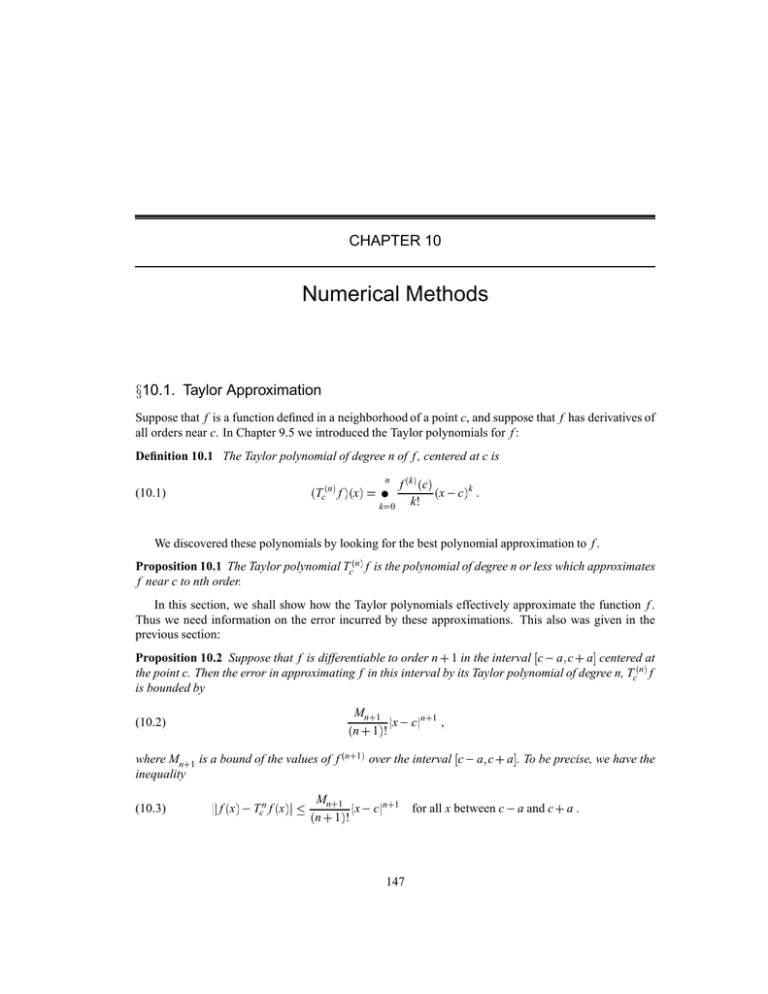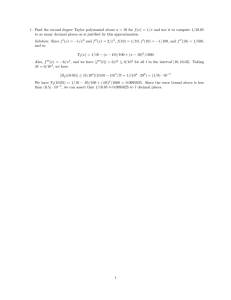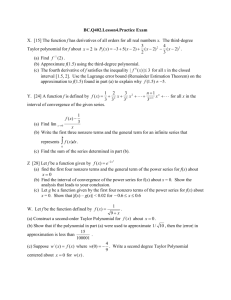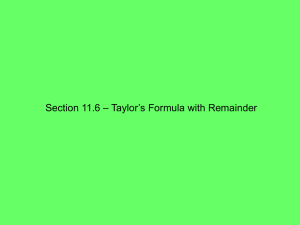Numerical Methods ∑ CHAPTER 10 10.1. Taylor Approximation
advertisement

CHAPTER 10 Numerical Methods x10.1. Taylor Approximation Suppose that f is a function defined in a neighborhood of a point c, and suppose that f has derivatives of all orders near c. In Chapter 9.5 we introduced the Taylor polynomials for f : Definition 10.1 The Taylor polynomial of degree n of f , centered at c is (n) (Tc (10.1) n f )(x) = ∑ k=0 f (k ) ( c ) (x k! c )k : We discovered these polynomials by looking for the best polynomial approximation to f . Proposition 10.1 The Taylor polynomial Tc(n) f is the polynomial of degree n or less which approximates f near c to nth order. In this section, we shall show how the Taylor polynomials effectively approximate the function f . Thus we need information on the error incurred by these approximations. This also was given in the previous section: Proposition 10.2 Suppose that f is differentiable to order n + 1 in the interval [c a; c + a] centered at the point c. Then the error in approximating f in this interval by its Taylor polynomial of degree n, Tc(n) f is bounded by Mn+1 jx (n + 1 )! (10.2) cjn+1 ; where Mn+1 is a bound of the values of f (n+1) over the interval [c inequality (10.3) jj f (x) Tcn f (x)j Mn+1 (n + 1)! jx cjn +1 147 a; c + a]. To be precise, we have the for all x between c a and c + a : Chapter 10 Numerical Methods 148 Before using this estimate, let us see how it comes about. To simplify the notation, we shall take c to be the origin. First, a preliminary step: Lemma. Suppose that f (0) = 0; f 0 (0) = 0; : : : ; f (n) (0) = 0. Then j f (x)j (nM+n 11)! jxjn + (10.4) +1 : Let’s show the case n = 1. We have j f 00 (s)j M2 for all s; 0 s x. So, for any t ; 0 t x, we have (10.5) j f 0 (t )j = j Z t 0 f 00 (s)dsj Z t 0 j f 00 (s)jds M2 Z 0 t ds M2t : But now, (10.6) j f (x)j = j Z x 0 f 0 (t )dt j Z x 0 j f 0 (t )jdt Z x 0 M2tdt M2 x2 2 : Of course, the same argument works for x negative, we just have to be careful with the signs. The argument for any n just bootstraps from this, proceeding from the estimate for n 1 to the estimate for n (this is called a proof by induction). Suppose we have gotten to the (n 1)th case. Then the lemma applies (at n 1) to the derivative f 0 ; so we know that (10.7) j f 0 (t )j Mn!n 1 jt jn + for all t in the interval [ a; a] : (We have Mn+1 because the nth derivative of f 0 is the (n + 1)th derivative of f ). Now we argue independently on each side of 0: for x > 0: j f (x)j = j (10.8) Z x 0 f 0 (t )dt j Mn+1 t n+1 n! n + 1 = Z 0 x j f 0 (t )jdt Z xM n+1 n t dt n! 0 Mn+1 jxjn+1: (n + 1)! The argument for x < 0 is the same; just be careful with signs. Now that the lemma is verified, we go to the proposition itself. Let g = f Tc(n) f Then g satisfies the hypotheses of the lemma. Furthermore, since Tc(n) f is a polynomial of degree n, its (n + 1)th derivative is identically zero. Thus g(n+1) has the same bound, Mn+1 . Applying the lemma to g, we have the desired result: j f (x) (10.9) Tc(n) f j Mn+1 jxjn+1 : (n + 1)! If this error estimate converges to 0 as n ! ∞, then we saw that f is be represented by its Taylor series: ∞ f (x ) = (10.10) ∑ n=0 in the interval [c a; c + a]. f (n) (c) (x n! c )n x10.1 Taylor Approximation 149 Before doing some examples, let’s review what has to be done. To use the Taylor polynomials to find approximate values to a function, we first have to find bounds Mn for the successive derivatives of the function. Then we have to calculate the values of Mn jx n! (10.11) c jn for successive values of n until we have found one which is within the desired error. Then we calculate using the Taylor polynomial of degree n 1. p Example 10.1 Find e to within an error of 10 4 . This is e1=2 , so we look at the function f (x) = ex . Since f (n) (x) = ex for all n, and the value x = 1=2 is within 1 of 0, we can use the Maclaurin series for ex and the bounds Mn = e1 . Since 3 is more manageable than e, we take Mn = 3. Now we estimate the error at stage n which we’ll call E (n). We have, in this example E (n) = (10.12) n=1: (10.13) n=2: (10.14) (10.15) (10.16) (10.17) (10.18) n=3: n=4: n=5: Thus, we have our estimate to within 10 (10.19) T05 (ex )(1=2) = 1 + 4 : E (1) = E (2 ) = E (4) = = 3 1 24 16 3 1 120 32 E (6 ) = 3 2 31 24 31 68 E (3 ) = E (5) = n=6: 3 1 n ( ) n! 2 3 48 = 3 384 = 7:8 3 1 720 64 < 10 10 4 by taking the fifth Taylor polynomial: 1 11 11 1 1 1 1 + + + + 2 2 4 6 8 24 16 120 32 Example 10.2 Find sin π =8 to within an error of 10 3. Here we start with the Maclaurin series for sin x: (10.20) 4 sin x = x x3 6 + x5 + 120 = 1:6487 Chapter 10 Numerical Methods 150 Since the derivatives of sin x alternate between sin x and cos x, we may take Mn need to choose n large enough that the Taylor error estimate E (n) satisfies (10.21) (10.22) E (n) = n=1: 1 π n 1 ( ) < 10 n! 8 2 E (1 ) = π 8 3 = :3927 n=2: E (2) = 1 π 2 ( ) = :077 2 8 (10.24) n=3: E (3) = 1 π 3 ( ) = :010 6 8 n=4: E (4 ) = 1 for all n. We : (10.23) (10.25) = 1 π 4 ( ) = :0009 24 8 so we need only go to n = 3. The estimate is (10.26) T03 (sin x)(π =8) = π 8 1 π 2 ( ) = :3826 6 8 or sin(π =8) = :383, correct to three decimal places. Some Taylor series converge too slowly to get a reasonable approximation by just a few terms of the series. As a rule, if the series has a factorial in the denominator, this technique will work efficiently, otherwise, it will not. Example 10.3 Use the Maclaurin series ∞ (10.27) ln(1 + x) = ∑( 1)n+1 n=1 xn n to estimate ln(1 + a) for a > 0 to within 4 decimal places. First we calculate the successive derivatives of f (x) = ln(1 + x) to obtain the bounds Mn . We have (10.28) so we can take Mn = (n (10.29) f (n) (x) = ( 1)n 1 (n 1)!(1 + x) n 1)!. Thus we need, for x = a: E (n ) = (n 1)! n an a = n! n < 10 4 : If a = 1=10, then the estimate occurs at n = 4, so the first three terms will do. But if a = 1=2, we don’t get this inequality until n = 12, so we’ll need 11 terms of the series. x10.2 Newton’s method 151 Figure 10.2 Figure 10.1 x0 x1 x2 x1 x0 x0 x1 x2 x10.2. Newton’s method Suppose that we want to estimate the solution of the equation f (x) = 0. If this is a linear equation, there is no problem: we just look for the point at which the line crosses the x-axis. Newton’s idea is that, since the tangent line approximates the graph, why not take as the estimate the point at which the tangent line crosses the x-axis? Well, to make sense of this, let’s start at some value x0 and calculate y0 = f (x0 ). If that is 0, then we’re through. If not, let x1 be the point at which the tangent line at (x0 ; y0 ) crosses the x-axis. That is our first approximation. If it is not good enough, replace x0 with x1 , and repeat the process, over and over again, until the result is good enough. This process is illustrated in figure 10.1. However, it doesn’t always work so well, as figure 10.2 shows. The important point is to start with a decent guess for x0 , so that we start in a range of the function where the concavity of the curve forces convergence of these successive approximations. Newton’s method thus, is a technique for replacing an approximation by a better one. Suppose we start with the function y = f (x), and have found an approximation x = a, with f (a) (relatively) close to zero. The slope of the tangent line at x = a is f 0 (a), and the equation of the tangent line is y f (a) = f 0 (a)(x a). This intersects the x-axis where y = 0, so we have (10.30) f (a) = f 0 (a)(x a) which has the solution x = a f (a) f 0 (a ) We now replace a by this value, and repeat the process. This is called a recursion given by the recursion formula (10.30). How do we know when we are within an error e of the solution? If the process is working, that is, if the successive approximations are getting closer and closer together, then we can stop as soon as they are within e of each other. If we have started with an estimate which is too far off, the process won’t work at all, and we’ll have to start with a better estimate. p Example 10.4 Find 8 correct to within 4 decimal places. Here we want to find the root of the equation f (x) = x2 0 f (x) = 2x, the next estimate is 8 = 0. Let’s start with x0 = 3. Since 32 8 = 2:8333 23 We now use this in the recursion, and continue until we reach stability in the first 4 decimal places: (10.31) (10.32) x1 = 3 x2 = 2:8333 (2:8333)2 2 2:8333 8 = 2:8284 Chapter 10 (10.33) Numerical Methods x3 = 2:8284 (2:8284)2 2 2:8284 8 152 = 2:8284 ; which we conclude is the estimate accurate to 4 decimal places. Before going on to other examples, we summarize the process: To solve f (x) = 0: 1. Calculate f 0 (x). 2. Calculate the recursion relation x0 = x (10.34) f (x) f 0 (x ) : 3.. Select a first estimate x0 , so that f (x0 ) is small and f 0 (x0 ) is large. 4. Find x1 from x0 by taking x = x0 ; x0 = x1 in the recursion relation. 5. Repeat step 4 until the successive estimates are no further from each other than the desired estimate. Example 10.5 Find the solutions of f (x) = x3 12x + 1 = 0 to three decimal places. First we graph the function so as to make an intelligent first estimate. We have f 0 (x) = 3x2 12, so the local maximum and minimum of y = f (x) are at (-2,17), (2, -15). At x = 0, y = 1, and the graph is as shown in figure 10.3. There are three solutions; one close to 0, another larger than 2, and a third less than -2. Figure 10.3: Graph of y = x3 12x + 1 x2 x1 x0 First, find the solution near zero. We see from the graph that the derivative is well away from zero in a range including x = 0 and the solution, so we can take our first estimate to be x0 = 0. Now we calculate successive estimates: x1 = 0 (10.35) (10.36) x2 = :08333 1 12 = 1 12 = :08333 (:08333)3 12(:08333) + 1 = :08338 ; 3(:08333)2 12 x3 = :08338 (10.37) so this solution is x = :08338 up to four decimal places. Now, to find the solution larger than 2, it will not do to take x0 = 2, since the derivative is 0 there. But if we take x0 = 3, we have f 0 (3) = 15, a nice large number, so the recursion should work. We find (10.38) x1 = 3 33 12(3) + 1 =3 3(32 ) 12 8 15 = 3:5333 ; x10.3 (10.39) Numerical Integration (3:5333)3 12(3:5333) + 1 = 3:4267 3(3:5333)2 12 x2 = 3:5333 x3 = 3:4215 ; (10.40) 153 x4 = 3:4215 ; so this is the answer correct to four decimal places. In the same way, starting at x0 third solution. = 3, we find the Example 10.6 Solve ex = x + 2 correct to three decimal places. Here f (x) = ex x 2; f 0 (x) = ex 1. Since the derivative is increasing, and greater than 1 at x = 1, and f (1) < 0, while f (2) > 0, a good first estimate will be any number between 1 and 2. So, take x0 = 1. The recursion is (10.41) x0 = x ex x 2 ex 1 = e x (x 1 ) + 2 ex 1 : We now calculate the successive estimates: (10.42) x1 = 1:16395 ; x2 = 1:1464 ; x3 = 1:1462 ; x4 = 1:1462 ; so this is the desired estimate. Notice that in this range, the derivative is not very large, so that the convergence is slower than in the preceding examples. x10.3. Numerical Integration We have learned techniques for calculating definite integrals which are based on finding antiderivatives of the function to be integrated. However, in many cases we cannot find an expression for the antiderivative, p and these techniques will not lead to an answer. For example f (x) = 1 + x3. No formula for the integral exists in any integral tables. In such a case, we have to return to the definition of the integral, and approximate the definite integral by the approximating sums. To explain this, we first review the definition of the definite integral. Definition 10.2 Let y = f (x) be a function defined on the interval [a; b]. The definite integral is defined as follows. A partition of the interval is any increasing sequence (10.43) fa = x 0 < x1 < < xn 1 < xn = b g of points in the interval. The corresponding approximating sum is n (10.44) ∑ f (x0i )∆xi 1 where ∆xi is the length xi xi 1 of the ith interval, x0i is any point on that interval, and ∑ indicates that we add all these products together (see Figure 10.4). Chapter 10 Numerical Methods 154 Figure 10.4: Approximation to the area under a curve. y = f (x) a b If these approximating sums approach a limit as the partition becomes increasingly fine (the lengths of the subdivisions go to zero), this limit is the definite integral of f over the interval [a; b], denoted Zb (10.45) f (x)dx : a Thus, we can approximate a definite integral by the sums (10.44). One way to accomplish this is the following. Pick an integer N, and divide the interval [a; b] into N subintervals, all of size (b a)=N. For each subinterval, evaluate the function at the right endpoint xi , and form the sum N (10.46) ∑ f (xi )∆xi = a) (b 1 N N ∑ f (xi ) Example 10.7 Let’s find an approximate value for into 10 subintervals. Then the sum (10.46) is (10.47) (Approximating Rectangles) 1 Z 1p 1 + x3dx this way. Let’s divide the interval 0 p p p 1 p ( 1 + (1=10)3 + 1 + (2=10)3 + 1 + (3=10)3 + 1 + (10=10)3) 10 1 = (1:0005 + 1:0040 + 1:0134 + 1:0315 + 1:0607 + 1:1027 + 1:1589 10 +1:2296 + 1:3149 + 1:4142) = 1:1330: Of course these calculations are tedious if done by hand, but, by computer - completely trivial. It is a good idea to try these using a spreadsheet, because there you get to follow the computation. If we take more subdivisions, we get a better approximation. For example, if we take N = 100 we get (10.48) p p 1 p ( 1 + (1=100)3 + 1 + (2=100)3 + 1 + (3=100)3 + 100p 1 + (100=100)3) = 1:113528 ; an apparently better approximation. Example 10.8 which we know to be (22:4 is (10.49) Z Just to see how well this method is working, let us use it to approximate 2 x1:4 dx, 1 1)=(2:4) = :1:782513 : : : . Let’s first take N = 10. The approximating sum 1 1:4 1:4 1:4 1:4 ((1:1) + (1:2) + (1:3) + (2) ) 10 x10.3 Numerical Integration 155 1 (1:1427 + 1:2908 + 1:4438 + 1:6017 + 1:7641 + 1:9309 + 2:1020 + 10 2:2771 + 2:4562 + 2:6390) = 1:8648: (10.50) For N = 100 we obtain the estimate 1.790712, which is better, but not great. We can improve this method by improving the estimate in each subinterval. First, note that we have estimated the integral in each subinterval by the area of the rectangle of height at the right endpoint. If instead we estimate this area using the trapezoid whose upper side is the line segment joining the two endpoints (see figure 10.5), it makes sense that this is a better estimate. Figure 10.5 y = f (x) a b This comes down to N 1 a) ( f (a) + 2 ∑ f (xi ) + f (b)) 2N 1 (b (10.51) (Trapezoid Rule) Going one step further, we might replace the upper curve by the best parabolic approximation. For N even, this leads to the rule a) 0 ( f (a) + 4 f (x1 ) + 2 f (x2 ) + 4 f (x3 ) + + 4 f (xN 1 ) + f (b)) (Simpson s Rule) 3N Let us now do the above examples using these two rules: Z 1p Example 10.9 The calculation of 1 + x3 dx using the Trapezoidal rule and N = 10 gives us (10.52) (b 0 (10.53) p p p 1 (1 + 2 1 + (1=10)3 + 1 + (2=10)3 + 1 + (3=10)3 + 20p p + 1 + (9=10)3 + 2) 1 (1 + 2 1:0005 + 1:0040 + 1:0134 + + 1:2296 + 1:3149 = 20 +1:4142) = 1:0123: Z Example 10.10 Let’s compare the estimates of N = 10, and the trapezoid rule: (10.54) 1 x1:4 dx with these two new methods. First, with 0 1 1:4 1:4 1:4 1:4 1:4 +2 (1 + 2 (1:1) + (1:2) + (1:3) + (1:9) = 20


